

Michael Walker - NanoJapan 2013
University of Florida
Major/s: Physics
Anticipated Graduation: May 2014
NJ Research Lab: Suemitsu Lab, Tohoku University
NJ Research Project:High Quality Graphene Formation on Improved 3C-SiC Epilayer
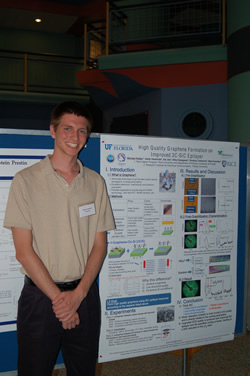
Why NanoJapan?
Becoming familiar with a culture different than your own, learning a new language, interacting with graduate students along with a professor, conducting cutting-edge research in a country that is a global flagship for technology - these are a few of the many opportunities that NanoJapan offers. It is important for undergraduates to pursue research as it builds a more intuitive approach to problem solving, while also strengthening what you may have already learned in the classroom. Also I think it’s clear that in science, as an international endeavor, collaboration is vital for progressive research. And while having many US scientists and great research institutions, it is beneficial to have colleagues that do not approach problems in a similar manner as you do, since sometimes your ability to solve a problem may be clouded by previous experience. So having international collaborators with different insight and technology (perhaps more advanced) than your own is advantageous.
I chose to apply to the NanoJapan program to cultivate my understanding of physics. At an early stage of what I hope is a lifelong interest in physics, I am interested in anything I can learn from. Carrying out research on a daily basis for an entire summer, I’ll be sure to hone some skills that are necessary for a physicist. I am most excited to do research on a material that has led to a Nobel Prize; graphene proves to have amazing properties that can be used to better the world. On the other side, realizing that US culture has its deficiencies, I enjoy learning and integrating different practices into my own. Japan’s unique culture and historic history will allow for this as it is mostly unknown to me. So not only am I excited for advancing my physics knowledge, but also being introduced to a different part of the world.
My goals for this summer are to:
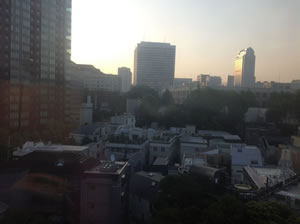
Land of the Rising Sun: Taken from outside my window at the Sanuki Club, my first picture in Japan.
My only expectation was to be surprised, which has certainly been met, and then some. Although I have only been in Tokyo for one week, I feel comfortable concluding a few things: the city is beautiful, Japanese people take pride in their work, and even though the culture is different there are many similarities. I was most surprised by the beauty and cleanliness of Tokyo. A twenty minute walk to language class and I haven't seen a single empty soda up, a plastic candy wrapper, nor a newspaper on the ground, astounding! Perhaps the most impressive aspect of Tokyo is the natural beauty, trees and shrubs fill the city, blooming roses are also found throughout. And as I mentioned, the pride of any worker is prevalent, at McDonalds all of the employees were polite and dutiful, same with Starbucks and Burger King - all fast food places where proper service is rare in the US.
Learning the Japanese language has been difficult for me so far. The style of teaching is similar to immersion, meaning a lot of information being thrown my way as I try to catch as much of it as I can. And while never having a good ear for picking up foreign words, I struggle with pronunciation. But after only one week I feel I have learned a ton; I can introduce myself, buy a few select items at a supermarket, ask a few general questions. In college I'm taking Latin and the styles of teaching are hugely different. First off, we learn vocabulary first, different conjugations and declensions without really putting it to use. The focus is to memorize, then put to use. Even though the styles are different, I trust Shimojo-sensi's technique as he's a professional in his field and very likeable. I can already tell the results, as I've been able to successfully use what I've learned in many occasions that usually end in a polite ありがとうございます along with a smile.
Observing others can go a long way in knowing what to do and what not to do. After two weeks in Tokyo I have definitely came across a few do's and dont's. Firstly, never stop on a staircase thinking you have time to look at your map (as 30 people are behind you rushing to get to their destination. A few other obvious observations are that people sternly abide by which side of the walkway to walk on given a certain direction, also on escalators you stand on the left if you plan on not walking up the escalator aka, while you let those who want to be extra fast the space on the right. Also on the subway you hardly see people talking, even if they are in a group. Sometimes I feel like a shush policeman trying to keep the tone of conversations low. It's funny when you aren't talking and notice how quiet the station is. I also notice the awareness of many Japanese people on the subway, always conscious of others trying to exit the subway, no words needing to be said, just a quick slide to the side that allows people to leave without any pushing. While on public transportation it's easy to notice the amount of people reading, mostly novels. You see more people reading novels than newspapers, let alone you hardly see anyone reading a pop-culture magazine. But similar to ways in America, you definitely see people on their electronic devices. And one thing that is very different, you don't see anyone attempting to lounge and take up two seats, most people sit fairly straight up and keep to themselves.
As a UF student who rides the bus everyday, you see student's taking up multiple seats all of the time. I'll admit I have practically zero subway experience in the US, but there are some observations I've made so far with the Japanese. Most people in the subway are riding alone. Most people walk quickly as well as stand near the door to enter/exit. And what I can't figure out, most people prefer the left side of the escalator, meaning they don't take the fastest way up the stairs. In some far out way this may relate to a sort of harmonious yearning, if everyone took the stairs, there would be a lot of running into's, and if everyone's took the escalator to walk up, that may get messy because some people are slower than others, and it's easy to trip on the next step. Also if you're older I imagine you'd prefer not to climb stairs, and since Japanese people respect their elders, they may not want to pass them in most instances. So maybe that's why it makes sense to Japanese, if everyone takes the same linear route that works 100% of the time (albeit slower than walking up the escalator) then your overall net efficiency is maximized...so it goes. I will add that I prefer to take the stairs in most instances because it feels good to stretch my long legs after sitting. Another thing you hardly see on the subway is people eating or even drinking for that matter. And even with little US subway experience, I'd say this is quite different. I do have US bus experience though, and can say for sure I've seen my fair share of people eating or drinking on the bus. I try not to, but if you're running late and haven't ate breakfast, it's too easy to eat a health bar on the bus while the driver isn't looking. In Japan, where you have very little authority overhead (on the subway) you have a culture that says eating or drinking on the subway is frowned upon. I can't blame the cultural decision, it keeps the place much cleaner, keeps odd smells out of the subway, and also keeps noise down (everyone knows how loud plastic wrapped food gets, or a bag of Doritos).
Learning Japanese the second week was much harder than the first. I kind of hit a point on Wednesday where information that accumulated after week 1 and week two started to mesh together. I was so-so comfortable with what I learned in week one, but when week two was finished I felt I had regressed some from week one since now I was so-so to below so-so on two weeks of lectures. I think the program is great though, I know that things will be a lot easier trying to self study, also I really enjoy all of my teachers from group. The most obvious difference between US and Japan, as far as language requirements go, is that in Japan you have to take English. In US you may have to take a foreign language, but most choose an easy language similar to their own. As far as using what I've learned, from Japanese class I talk to this 7-11 man who is very cool to talk to. His English is good and he'll talk in Japanese, which is good since what happens a lot of the time is you'll try talking Japanese to someone, then they talk English back and it ruins the learning experience. The best part about this week was walking with the people at AJALT, wow what a time. Going into the talk I was a little nervous, I didn't want to embarrass myself. But the girl I talked with was such a sweetheart with a beautiful smile I couldn't help myself but enjoy the talk.
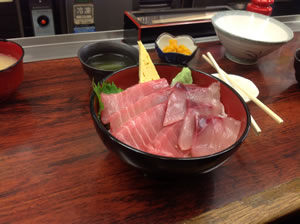
Sushi from the Tsukiji Fish Market
As June 2nd approaches I am most excited for doing actual research and learning some physics. You can't beat one on one learning with a knowledge source, such as a grad student or some other higher up. Suemitsu-sensei talked at Sanuki club so I met him there and he seemed very cool. He also invited Lila, Ray, and me to an orchestra performance. I am most nervous about my room being too hot or humid, although I haven't heard it to be either, but it's hard to sleep for me when the room is too warm.
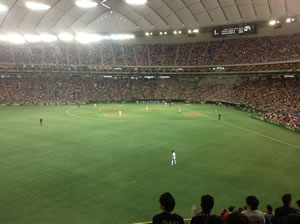
Tokyo Giants Baseball Game
Minami Sanriku was an excellent reminder that catastrophic events can happen anytime to anyone, and that it's devastating when it happens to an entire town. After such an event I think the only way to get by as a society is through cooperation, understanding, and high spirits. If pictures are a thousand words, then being there is one million. While in Minami-Sanriku it was easy to understand the slogan "town that disappeared." I had seen before and after pictures, but seeing the aftermath in person was a different experience. Being able to walk through a parking lot that was once a buzzing living area, or seeing what use to be an area packed with boats completely out of use because the boats had landed a few miles in land gave me a feel for what use to be.
One of the best experiences was the first day up and we had the opportunity to play with little kids. As the bus pulled up we could see them all in the window waving, so excited to see us and play. After taking off my shoes I could see the smiles on these cute kids and I couldn't help my grin ear to ear, never having met me or seen me they were ecstatic just at the first site to see a group come play with them. Before playing outside though, we had a few large white posters and everyone dipped their hand in paint then left their print on the paper. I helped many do it since it wasn't exactly straight forward, and even with relatively zero working knowledge of the language I was able to communicate through gestures. We then made paper airplanes which was really neat, when we handed the paper out the kids knew exactly what to do, and many planes ended up better than my own. Once outside the slew of planes were taking off and landing recklessly, then we played little games such as soccer or throwing a ball back and forth. Being tall I'd pick up kids and they'd love it, and although one little guy was very scared at first, after going up he decided he didn't want to go down! Leaving after an hour of play was again another very heart felt experience, they would follow us out and we'd disappoint saying we had to go. They lined up against the fence to wave goodbye, and as the bus road off they chased afterwards still waving.
Then came the 5th grade build a bridge contest. I had a bigger group and my Japanese KIP member could not speak very good English, so to say the least, communication with the 5th graders was quite difficult. I had difficulties trying to keep everyone on task and motivated to work on building the bridge, but we made it through and our bridge could support 3 small books and a pencil case. It was so funny seeing the kids place objects on the bridge, they would do it slowly and be like OOOOH when they saw the bridge still standing! And the more we added, the bigger the surprise was.
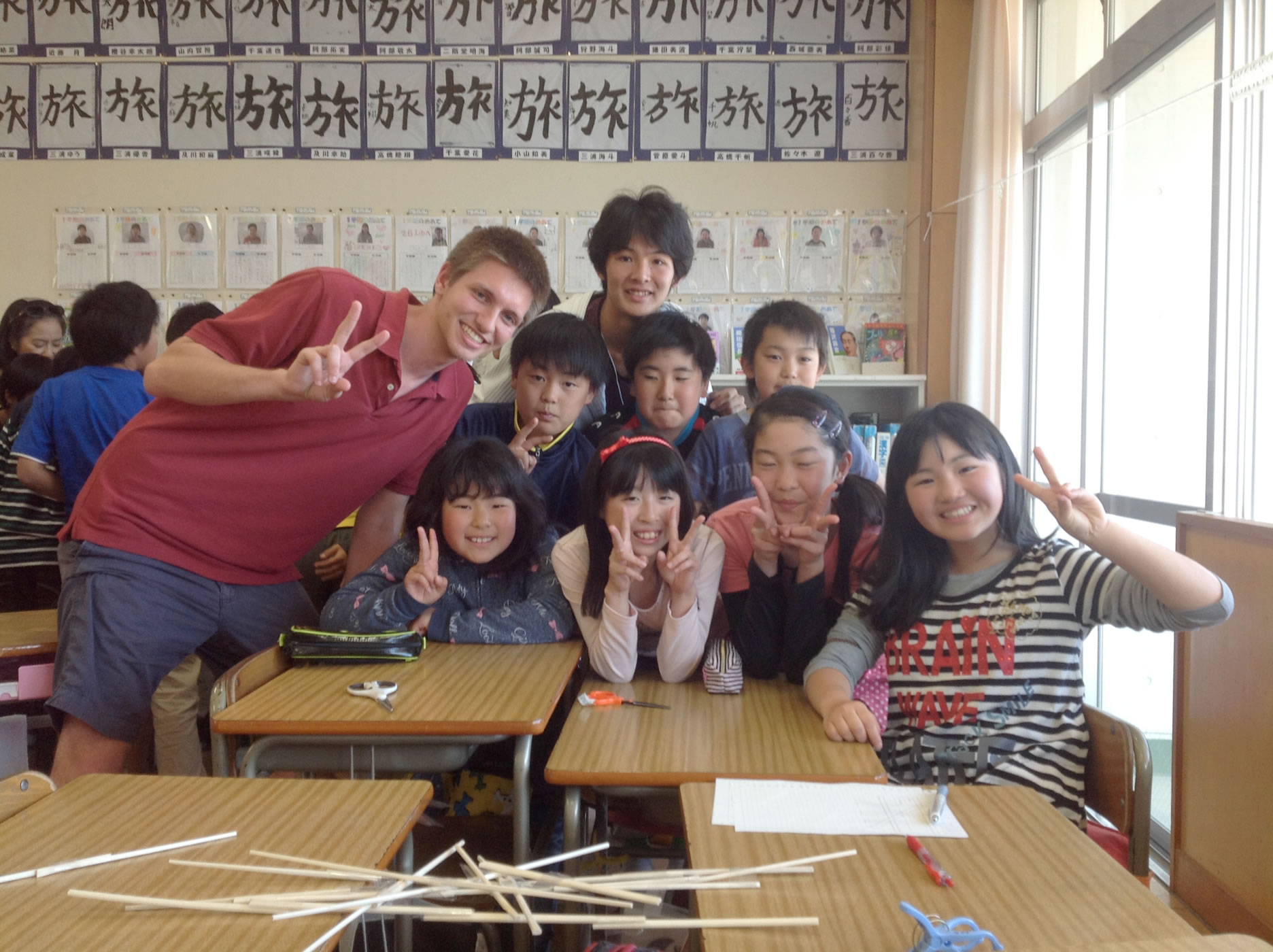
My bridge building team at the elementary school we visited.
The following day we played with the entire elementary school for a few hours. I mainly blew bubbles with the kids since it required no running and I loved blowing bubbles when I was young! I also played tag, which was more running than I expected, I felt bad when I had to stop because I was so tiered, the kids wanted to play so badly they would tug on my shirt and follow me around.
The last night in Minami-Sanriku we had dinner with a few members of the temporary housing unit near the place we were staying. Afterwards many of us went with the temporary housing members back to their social building and while they drank we would listen through translation. I sparked a conversation with this one elderly man about baseball and he was so excited that I knew the Japanese baseball players in US Major League Baseball, he told me his opinions on them and what they meant to Japan, I had never realized how iconic some of the players were. After speaking with him for 15 minutes I had to go, I was sad to leave but he was extremely happy to have talked about baseball. This had to be the most impactful event, I can't really explain how it felt and I know I'm not doing it justice through text, but it was a special time.
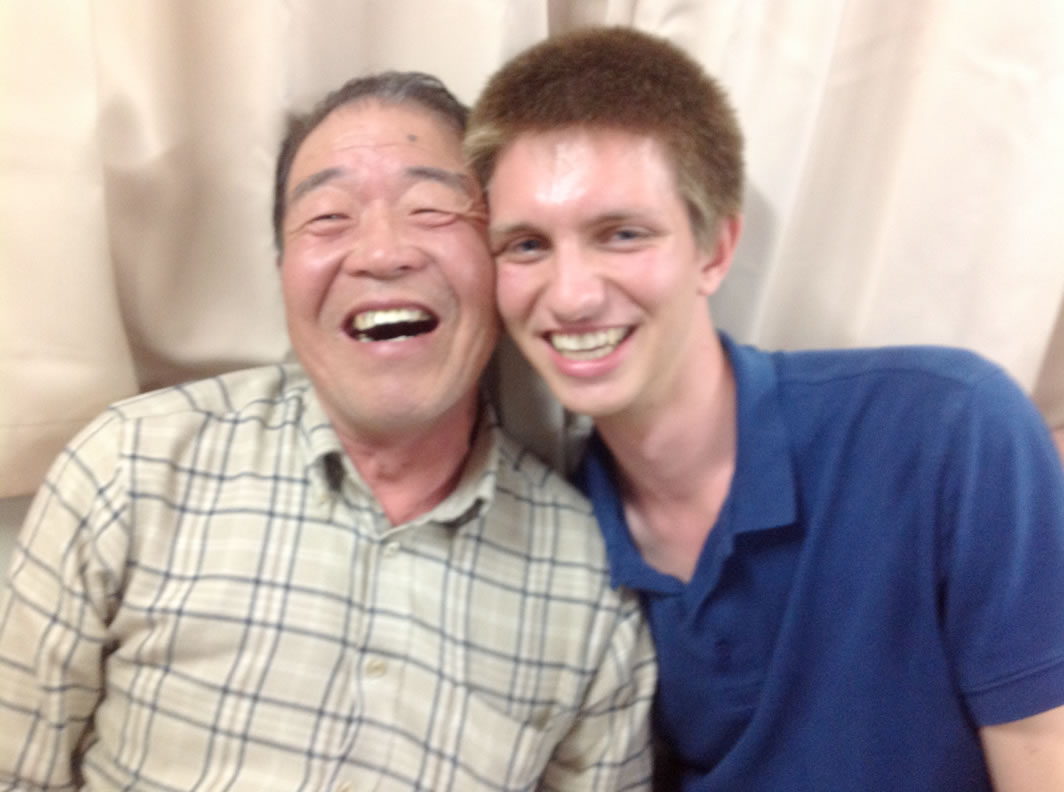
Me with the old man I spent time talking to about baseball.
From the recovery efforts in the Tohoku I got a sense of the close-knit culture of the Japanese society. How the people who were effected were going to get through the disaster together, which I think is the only way sInce you can't build a city by yourself. And after two years I feel people still take the event very seriously, anyone I've talked to always pauses for a second, remembering how that day and the following unfolded for them. As for what the U.S. can do to help the recovery process I would say money for helping the locals rebuild and get back the essentials, but also show emotional support and let the locals know all is not lost, that there are better days ahead. But mainly money and perhaps some companies can help rebuild some of the city.
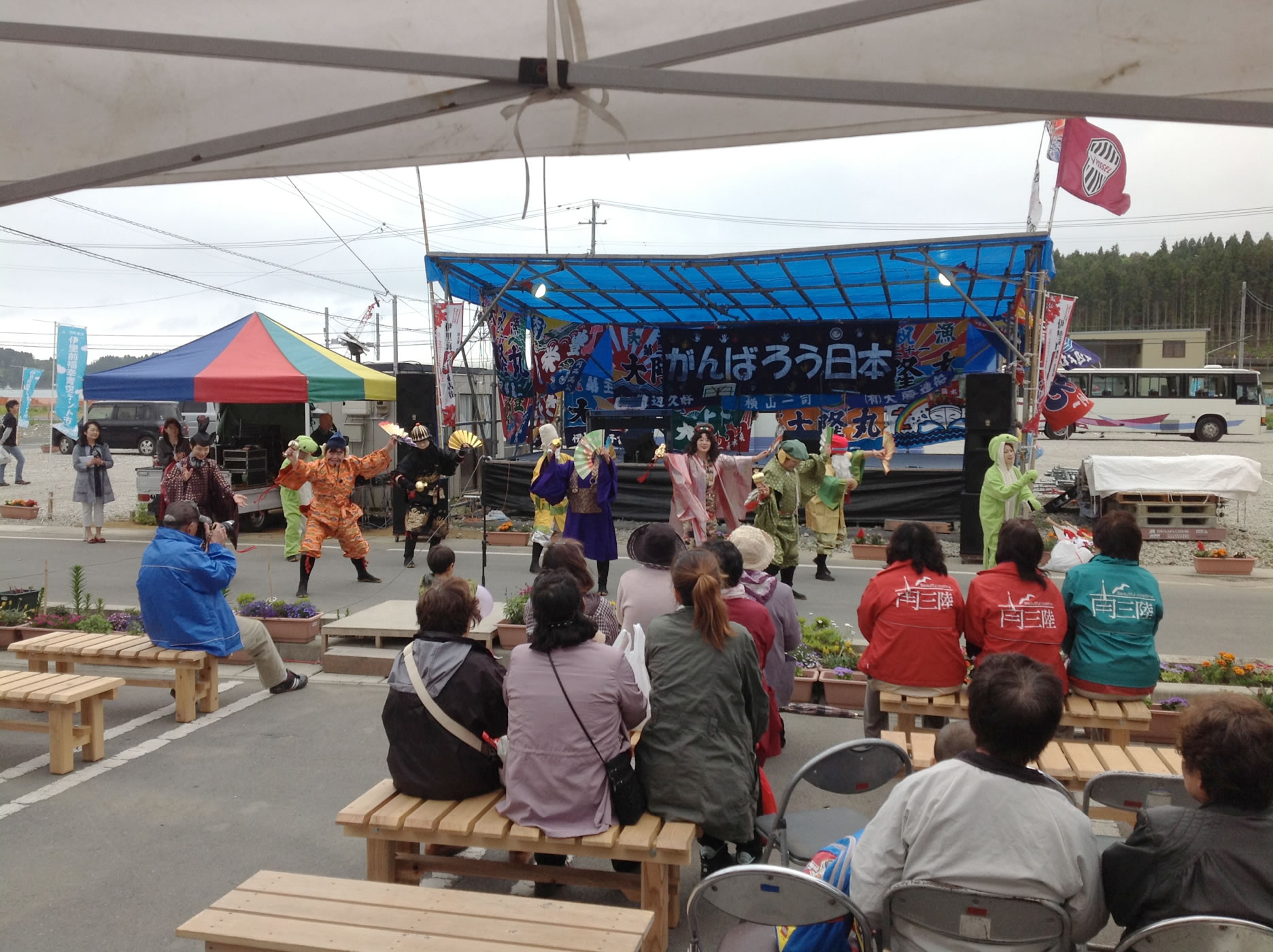
Festival in Minami Sanriku
On the last day while departing we stopped for a minute to buy some souvenirs and we happen to see a small festival going on with a band and several stands selling food. This made me hopeful for the future of the city, that it has a strong culture that is worth preserving. Also the area is beautiful, which will always attract people to invest time, money, and resources into the area.
I was excited as I left for lab. I woke up early and was well on my way by 8 o’clock to meet Suemitsu-sensei at 9:30. Luckily I left early because I ended up losing my way and what was supposed to be a 25 minute walk ended up taking 85 minutes. Suemitsu-sensei was there punctually at 9:30 and was happy to see me, finally after months of e-mail exchange and preparing to meet this man he was right here in front of me! And his personality matched that of his e-mails, an energetic, kind, English-speaking Japanese professor. We greeted each other, then went upstairs to his office where he gave a one-on-one brief lecture of what I would be doing, which was extremely helpful as I was comfortable to be there and ask questions and he could explain to me difficult concepts with ease. Half an hour later, he had all of the lab mates come in and introduced me, we then continued to make a power point listing everyone’s name, purpose in the lab, and my schedule throughout the lab, he then later sent me the power point which was very helpful for everyone’s names’! Then everyone left and it was just Suemitsu-sensei and I, he received a phone call and said I could go; I was a little lost since he didn’t show me anywhere else and I had zero clue what I was supposed to be doing.
Luckily the next room down the hall had everyone and I was showed to my desk and given some material to read. Then one of the lab mates, Sai-san, gave me a tour of the lab - about 7 different rooms filled with highly specialized machines and cluttered papers. I was like a 5 year old in a candy store, I wanted to know about and use every machine I saw! After the tour everyone (including Suemitsu-sensei) went out to lunch, which was great because it was a relaxed atmosphere and easy to talk to my lab group. When we returned to the lab, another student who I mostly tag along with let me watch him use a machine and told me all about it. Overall there isn’t a direct mentor, more like Sai-san and the guy previously mentioned, which sadly his name escapes me L. One thing in the lab is that the machines take time to do their job, roughly two hours, so there is quite a bit of down time, which isn’t all too bad as it gives me time to read and learn about what is actually happening. Concluding my first day at lab I went in to tell Suemitsu-sensei I was leaving and he was kind enough to give me a sweet that he was eating, this concluded a very fine first day at lab.
By the end of the first day I could tell the lab was mostly going to be in English. Sai is Chinese and has been in France the past 7 years, speaks very fine English but not a lick of Japanese. Because of this, the lab has been speaking in English the past few months and just about everyone holds their own in conveying basic instructions or happenings. We even had a group meeting on the second day and everything was in English so Sai (and myself) could understand.
Resaerch Project Overview: Starting with a Si wafer in an ultra high vacuum (UHV), we introduce monomethyl-saline (MMS) into the chamber at a high temperature. After two hours of this combination, a thin film of Silicon-Carbide will lie on top of the Si wafer. Then we place this Si/SiC wafer into a different chamber where we can introduce a new mechanism where the result is graphene a few nano-meters thick on top of the SiC, so the final result is a Si/SiC/Graphene wafer. The quality of the end product is in question, so we have to experiment what are the best conditions for growing each stage, variables to keep in mind are pressure and temperature. I do not know too much about the equipment we will be using other than some of the names, but XPS, TEM, SEM, AFM are among some of the machines I’ll be using. –more to come on this in later reports.
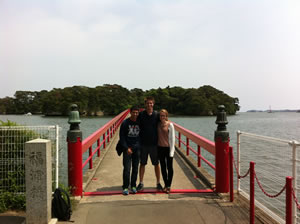
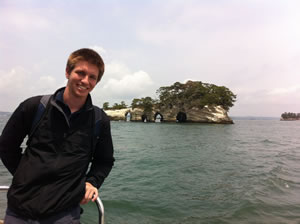
Lila, Ray, myself in Matsushima Islands
So far there hasn’t been a time where any significant cross-cultural mistake occurred, but there have been a few small ones. This past week I had asked Nagasawa-san, who works in my lab, how much it would cost to mail a post card to the US, he didn’t know but said he would check later. During the same day I asked how much a typical hair cut would cost and once again, said he didn’t know but would check later. Packed up and headed out he sees me leaving but kind of rushes to me and gets me to come to his computer so he could check online and answer my questions. I kindly denied saying no problem and I’ll check when I’m home. He insisted that he show me, so he spent the next 10 minutes helping me out, which was greatly appreciated since he gave me exact amounts and he even gave me precise directions to a cheap hair dresser. I thought this was quite different than in US culture as most people would have just let me check at home and save them the time, let alone go the extra mile of giving me directions. Although this was very nice of Nagasawa-san, I did really want to leave because I had stayed later than usual and was hungry; but I recognize how caring and thoughtful his actions were.
Another small instance was during the same day at the hair dressers’. I had no way of verbally communicating the hair cut I wanted, so I motioned a buzz over my hair and then asked how much. She typed 2,200 into her calculator, I then asked for the cheapest they have and she then typed 1,800 and said no shampoo and I said okay. So she takes me to the chair (which was rather comfortable compared to typical US ones) and begins the buzz. As she goes on I try to add specifications, shorter on the sides and no side burns. Every now and then she would ask something in Japanese, I’d smile and seeing her in the mirror she’d smile too and we’d laugh because I had NO clue what she had said. During the cut I figured I was having a good time and wanted the shampoo and would pay the extra 400 yen. The end result was great, I couldn’t of asked for a better hair cut. When she asked me to stand, I stood, and then she led me to the shower station and shampooed my newly cut hair (without me asking) and she even clipped some extra hairs that must have been standing out. When paying I tried to give her 2,200 yen because I had the shampoo, and plus she was excellent. She wouldn’t accept my money even though I insisted. A few English thank you’s and I was on my way home. This was quite different than US culture, where I received free service (shampoo) and then willingly try to give her the money she denies, this doesn’t quite fit in the typical US business plan. In this instance I think she was being nice (maybe because I’m a foreigner) or she was being true to her word that the hair cut would cost 1,800 yen.
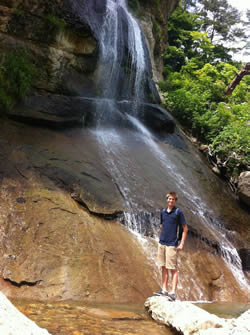
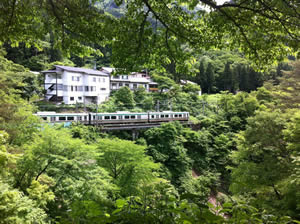
Omoishyuma – where Lila, Ray and I went hiking
Research Update: Research is going well, I talk with Professor Stanton every Monday and my lab mates are all very helpful if I have any questions. At the lab I have a few hand-written papers describing everything I’ve done and the reasons for it in prep to writing a formal paper. This past week we took XRD, AFM and SEM of my specific sample; we had a few troubles and took some time to resolve the issues. I have pictures of the results which are also at the lab, I will gather them and put everything on my next weekly update. Overall my sample of SiC is considered to be higher quality than previous samples, so we have high expectations for high quality graphene. On Monday we put the sample into a chamber in order to anneal it, this is the graphitization process. The Si of the SiC thin film on the Si substrate with sublimate, leaving only carbon on the surface and the carbon will spontaneously realign itself in a lower energy formation, forming graphing.
I am lucky enough that Suemitsu-sensei has implanted a very liberal atmosphere in the lab, with little overbearing on every moment activities. The lab students share one large room, each having their own desk and computer, while Suemitsu-sensei’s office (where he spends most of his time) is just one door down the hall. Every Monday there is a group meeting where each student gives a powerpoint covering what they’ve done in the past week, what they plan on doing this week, and what they plan on doing next week, there is also one slide committed to the schedule covering the next 8 or so months. Suemitsu-sensei attends and remains attentive throughout, giving constructive feedback to each lab member. Other than this, Suemitsu-sensei trusts that the group will work at its own pace, with the students motivated to meet personal deadlines for their research. Also, I notice the other students are very relaxed while they are in the lab. Sometimes mid afternoon you can see one napping; one time Suemitsu-sensei came in and only joked about the person would wake up with a red mark on her face. The lab students usually arrive around 9am and usually stay past 6pm, so I’m sure they accomplish their tasks, but perhaps on a less minute by minute structure. Another excellent characteristic of the lab is that every day most of the students and Suemitsu-sensei go out to lunch and socialize in a very laid-back manner. With all of this said, I doubt this is the typical Japanese-style state of the art research lab atmosphere. I see where this type of atmosphere can lead to an unproductive lab if taken advantage of. But, maybe Suemitsu-sensei recognizes that the students will excel in a relaxed atmosphere where he offers constructive criticism, as well as being very approachable. This may be attributed to the Japanese culture where people more often take pride in their jobs and more often perform their task to the best of their abilities.
Research Update: This past week was a little slow since two of the top members (Suemitsu-sensei and Sai-san) were out of town for a conference. None the less, I did a lot of reading, specifically about the growth of graphene on our 3C-Sic/Si substrate. So far this week, we completed the graphitization process, except when we did the Raman Spectroscopy graphene was not found! So today (Tuesday) we altered the growth conditions (made warmer) and we expect graphene to form.
Outside of research my biggest personal accomplishment has been what I’ve done on the weekends. Trips to Matsushima, Omoshiroyama-Kogen, Yamadera and Zao Onsen, attending Oktoberfest in Sendai have made for wonderful adventures with my good friends Ray and Lila. It would be easy to remain sedentary, not knowing the language, not wanting to spend money, having research, having to take a train to get anywhere outside of Sendai; all excuses that make it oh-so-easy not to explore the beautiful country of Japan. Overcoming these pleas for relax time, I have tried to make every minute useful which has in turn made my summer truly great, remembering not the times spent on Facebook, but the fantastic journeys. My biggest personal challenge thus far has been trying to get quality sleep. Simply put, my bed is awful, and perhaps my boney shoulder offers little cushion so waking up sore is common. Also outside my window is a small, but busy road with screeching cars and bicycles.
Things are progressing nicely in my lab. Now that the experiment has concluded, we’re analyzing our substrate with different machines. Meeting deadlines shouldn’t be a problem.
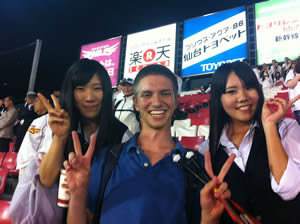
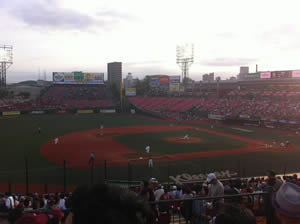
Baseball Game
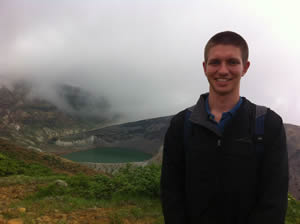
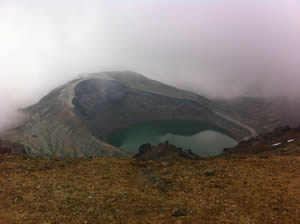
Mt. Zao